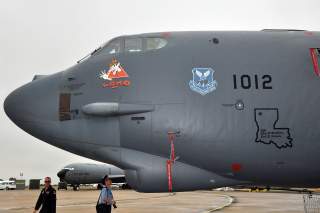The Air Force Has a Big Plans for the B-21, B-2, B-1 and B-52 Bombers
And Russia and China won't like it.
The Air Force’s recently released Bomber Vector calls for wide range of new technologies for the fleet - to include newer stealth materials, faster computer processors, upgraded weapons and new sensors to ensure the force will still be able to launch attacks in more advanced, future high-threat scenarios spanning into the 2050s.
The new Air Force bomber fleet plan, released in conjunction with the service’s 2019 Budget request, also seeks a larger bomber fleet and maps a modernization and production trajectory for the introduction of the emerging B-21 Raider in the mid-2020s.
“The Air Force’s Bomber Vector established the overarching future planning guidance for the Air Force bomber force. The force must include both standoff and stand-in capabilities, hinging on use of stealth and other technologies,” Maj. William Russell, Air Force official, told Warrior Maven in a written statement.
While the fleet size and force configuration details outlined in the vector have received much attention, a lesser discussed - but potentially more significant - element of the new plan centers on the integration of a new generation of bomber technologies intended to both inform the B-21 and launch a massive overhaul of the existing fleet of B-52, B-2 and B-1B bombers.
Recommended: North Korea’s Most Lethal Weapon Isn’t Nukes.
Recommended: 5 Worst Guns Ever Made.
Recommended: The World’s Most Secretive Nuclear Weapons Program.
Also, the advent of new technologies introduces new combat tactics expected to take center stage in coming years. This includes things like artificial intelligence being used to process and organize ISR data, manned-unmanned teaming involving a more extensive use of attack and reconnaissance drones as well as longer-range air dropped weapons. All of these fast-evolving innovations can quickly bring new tactics, as longer-standoff ranges enable bombers to potentially achieve a strategic advantage through improved positioning and lower-risk flight plans.
With the vector, the Air Force hopes to sustain its fleet of bombers such that they remain capable of attacking near-peer adversaries if needed, such as Russia or China, known to possess advanced air defenses, stealth fighters, long-range attack weapons and other kinds of anti-access/area-denial technologies designed to counter stealth bomber attacks.
Upgraded and next-generation stealth technology will, according to Air Force developers, figure prominently in coming decades; the Bomber Vector plan calls for the service to progressively phase-out B-1s and B-2 bombers as the new B-21 comes online in the next decade.
“The advantages of stealth technology will be an essential tool for any aircraft operating in or around the reach of advanced air defenses for the foreseeable future. We will continue to research additional technologies to enhance or replace stealth technology in response to increasing threat capabilities,” Russell said.

